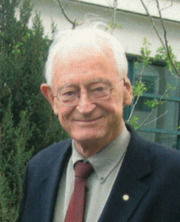Alan G. MacDiarmid para niños
Datos para niños Alan Graham MacDiarmid |
||
|---|---|---|
 El autor, en Pekín, 2005.
|
||
| Información personal | ||
| Nacimiento | 14 de abril de 1927 Masterton, Nueva Zelanda |
|
| Fallecimiento | 7 de febrero de 2007 Drexel Hill, Pensilvania |
|
| Causa de muerte | Muerte por caída desde altura | |
| Sepultura | Arlington Cemetery | |
| Nacionalidad | estadounidense y neozelandés |
|
| Lengua materna | Inglés | |
| Educación | ||
| Educado en | Universidad Victoria de Wellington University of Wisconsin–Madison |
|
| Información profesional | ||
| Área | químico y profesor universitario | |
| Conocido por | Polímero conductor | |
| Empleador | Universidad de Pensilvania, Universidad de Saint Andrews, Universidad de Texas en Dallas | |
| Miembro de | ||
| Distinciones | The Francis J. Clamer Medal en 1993 Premio Nobel de Química - 2000 |
|
Alan Graham MacDiarmid (nacido en Masterton, Nueva Zelanda, el 14 de abril de 1927 y fallecido el 7 de febrero de 2007) fue un químico y profesor universitario. Tenía doble nacionalidad, estadounidense y neozelandesa. Es muy conocido por haber ganado el Premio Nobel de Química en el año 2000.
Contenido
¿Quién fue Alan MacDiarmid?
Alan MacDiarmid fue un científico muy importante que dedicó su vida al estudio de la química. Nació en Nueva Zelanda y luego se mudó a Estados Unidos, donde desarrolló gran parte de su carrera.
Sus estudios y carrera profesional
Alan MacDiarmid obtuvo su doctorado en química en la Universidad de Wisconsin en 1953. Después, continuó sus estudios en la Universidad de Cambridge en 1955.
Ese mismo año, comenzó a trabajar como profesor en la Universidad de Pensilvania. En 1964, se convirtió en profesor titular. Desde 1988, ocupó una cátedra especial de Química en esa misma universidad.
Su vida personal
Alan MacDiarmid tuvo cuatro hijos con su primera esposa, Marian, quien falleció en 1990. Más tarde, se casó con Gayl Gentile. Falleció el 7 de febrero de 2007 en su casa de Drexel Hill, Pensilvania, después de una enfermedad.
Descubrimientos científicos de Alan MacDiarmid
Alan MacDiarmid es famoso por sus investigaciones sobre los polímeros orgánicos que pueden conducir la electricidad. Imagina un plástico que, en lugar de aislar, ¡permite que la corriente eléctrica pase a través de él!
¿Cómo empezó su investigación?
Sus estudios en este campo comenzaron en 1975. En ese año, se puso en contacto con el doctor Hideki Shirakawa, un científico del Instituto Tecnológico de Tokio. A partir de entonces, trabajaron juntos muy de cerca. También colaboró con el doctor Alan Heeger, un físico de la Universidad de Pensilvania.
Polímeros conductores: ¿Qué son?
Los polímeros conductores son materiales plásticos que tienen propiedades similares a los metales, es decir, pueden conducir la electricidad. Esto es sorprendente porque la mayoría de los plíasticos son aislantes.
Alan MacDiarmid se interesó mucho en un polímero conductor llamado polianilina. También investigó los polímeros orgánicos que emiten luz, lo cual es útil para pantallas y otros dispositivos.
Publicó más de 600 artículos científicos y obtuvo más de veinte patentes. Esto demuestra lo mucho que contribuyó al campo de los polímeros orgánicos conductores, como el poliacetileno y la polianilina.
Reconocimientos y el Premio Nobel
Recibió muchos premios por su trabajo. Uno de los más importantes fue el Premio en Materiales Químicos de la Sociedad Americana de Química en 1999.
En el año 2000, Alan MacDiarmid fue galardonado con el Premio Nobel de Química. Este premio lo compartió con el físico estadounidense Alan Heeger y el químico japonés Hideki Shirakawa. Lo recibieron por su gran aporte al desarrollo de la ciencia y las aplicaciones de los polímeros orgánicos que pueden conducir la corriente eléctrica.
Galería de imágenes
Véase también
 En inglés: Alan MacDiarmid Facts for Kids
En inglés: Alan MacDiarmid Facts for Kids


